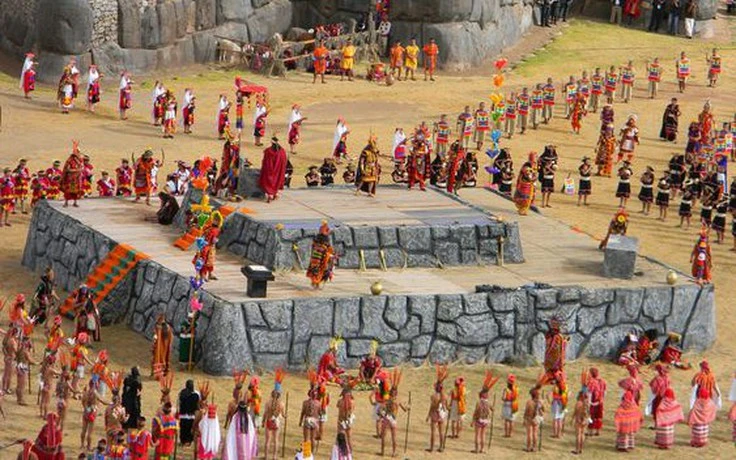Peru Reveals the Ancient Andean Thundering Dancing Floor

An open-air “sounding” dance floor in Peru has been discovered, designed to mimic a drum-like sound, perhaps for a thunder god when stomped upon! Built sometime between 1000 and 1400 AD, the site called Viejo Sangayaico is located 200 kilometers (124.2 mi) southeast of the Peruvian capital of Lima. It was also very much in use during Inca rule between 1400 and 1532, and possibly even during the early years of the Spanish conquest.
Association with the Divine: Summoning the Thunder God through Dance
“We know that in pre-Hispanic Andean rituals dance was a big part of the proceedings. I believe that this specially constructed platform was built to enhance the natural sounds associated with dance,” says Kevin Lane, an archaeologist with the Instituto de las Culturas (IDECU) of the Universidad de Buenos Aires in Argentina, who led the research.
The sole author of the study, Lane had his research published in the Journal of Anthropological Archaeology. “The larger site’s association to veneration of Andean lightning and thunder deity suggests that dancing at this location might have been in part attuned to this supernatural entity,” he writes in the paper.
Amongst the stunning Andean landscape, where myths and beliefs converged with the rhythms of nature, this site served a unique function, perhaps even facilitating direct communication with the divine through ceremony. It was not just a stage for performances and function, as the research points to the association of a possible Inca temple dedicated to the lightning deity.
It was positioned to face the nearby mountain of Huinchocruz, with a revered site featuring a pre-Hispanic ceremonial platform known as an ushnu. The dance floor was built on one of two open-air platforms.
“I believe that these open platforms would have been used during the pre-Hispanic period as a stage on which to venerate the nearby mountain gods, in this case those of Huinchocruz,” Lane explains.

The partially excavated dance platform discovered by investigators at Viejo Sangayaico, Peru. (Image Courtesy of Prof. K. Lane)
Sound has been recognized as an essential element in Andean rituals and ceremonies, where it was believed to have a powerful connection to the spiritual realm. Acoustic archaeology, a sub-discipline of archaeology, focuses on studying the use of sound in ancient cultures and how sound was manipulated within architectural spaces to evoke certain emotions or convey messages.
Drawing on the Andean belief system that associated lightning deities with rain and thunder, scholars suggest that the Viejo Sangayaico dance floor was conceived as a means to mimic the awe-inspiring sound of thunder. Lane postulates that the ancient inhabitants likely engaged in rhythmic performances, accompanied by the resonant beats of drums and the haunting melodies of Andean wind instruments, reports The Art Newspaper.
Ukko, The Mighty Finnish God of Thunder and Lightening
A Strange Ancient Dance with Unknown Origins – How Far Back Does the Morris Dance Really Go?
A Serendipitous Stumble: Uncovering the Dance Floor
The archaeological team’s first encounter with the sounding dance floor was serendipitous. As they stepped onto the platform, a hollow echo reverberated through the air, which piqued their curiosity. Realizing that this was no mere coincidence, the researchers embarked on an exhaustive excavation, bit by bit unearthing the ingenious construction that lay beneath their feet.
A diverse array of materials was designed to enhance the percussive sound, with the platform’s unique design consisting of four layers of carefully prepared fills. These layers comprised a mixture of camelid guano and clean silty clay, strategically interspersed to create the desired percussion effect. The carefully placed gaps within the dung layers contributed to the production of a deep, bass-like sound that enveloped the dance floor, measuring approximately 10 meters (32.8 ft) in diameter.

“We reckon the platform could have held up to 26 people dancing in unison, making for a loud thumping sound,” Lane says. Perhaps, the dust raised by the dancing was a visual feature to add to the larger effect of the performance.
Thunderbolt and Lightning: The Divine Spark That Shaped History
12 Absolutely Amazing Artifacts of the Inca
Sound Enhancement at Other Andean Sites?
Other Andean sites were also built around the enhancement of sound. If anything, this is a further reminder that future exploration and excavation must be nudged in this direction. The Viejo Sangayaico dance floor is clearly not an isolated phenomenon but rather representative of a broader cultural practice. The profound significance of sound in ancient Andean rituals had long been acknowledged in sites like Chavin .
Another Peruvian Andean site, Huánuco Pampa, displays the potential for this, and a series of new studies are emerging in this wake. It appears that the Andean civilization had harnessed the power of sound to forge a sacred connection with their deities and the cosmos. The rhythmic reverberations of their dances likely transcended the temporal realm, allowing ancient Andeans to communicate with the divine.
“The sounding dance platform is a fantastic find and it shows that, aside from instruments, the human body and the landscape could be employed musically. It also brings past sounds to life, especially given that the past is mostly silent and lost to us,” poetically concludes Lane.